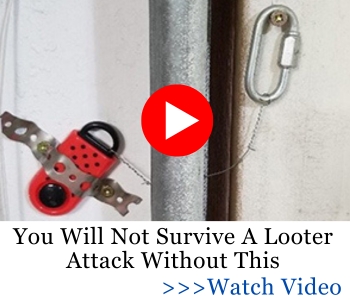When the grid dies, whether from storms, cyber-attacks, or infrastructure failure, having a reliable emergency power supply (EPS) isn’t just handy: it can save lives, protect valuables, and keep your household running. Let’s break it down.
Our power grid is more fragile than most people realize. Between aging infrastructure, supply chain vulnerabilities, and increasing weather extremes, blackouts are no longer a rare event, they’re part of modern life. As preppers, we plan for worst-case scenarios. A long-term outage during the dead of winter or peak of summer could be deadly without the right preparations.
And it’s not just about lights and convenience. The minute power goes out, so does access to refrigeration, communication, home security, and in many cases, heat or water. Power grids going down are like EMPs hitting us.
An EPS turns a blackout from a crisis into a manageable situation. Let’s take a hard look at what an emergency power supply is and how to choose the right one for your home and bug-in plan.
What Exactly Is an Emergency Power Supply?
An EPS is an independent electrical backup for when the lights go out. It can range from a small battery-powered UPS (Uninterruptible Power Supply) that bridges seconds-long outages to large standby generators that run for hours or days. The right one for you depends on your environment, energy needs, and how long you expect to be without grid power. We will talk more about this below.
There are two basic categories: temporary/portable and permanent/standby. Portable systems, like battery banks or gas generators, are great for short-term or mobile needs, like powering a campsite or essential devices during a storm. Standby systems are designed for long-duration outages and can be integrated into your home’s electrical system for near-seamless power.
First Thing First: Know Your Power Needs
Before you go shopping for a backup system, you need to know exactly what you’re trying to power. Every watt counts, and wasting energy on non-essentials could leave you in the dark when it matters most. This step is about prioritizing your survival and comfort, nothing else. Basically, if your home is not around 4,000 square feet, with central HVAC, electric stove, general use appliances, and a well pump, you do not need something as strong as the Westinghouse 28000 Watt Home Backup Portable Generator. Math counts here.
Start by listing critical devices you want powered:
- Communication gear (ham radio, cell phones)
- Lighting (LED lanterns, headlamps)
- Refrigeration or medical equipment
- Heating/cooling systems
- Tools or pumps
Add up their wattage. That tells you what capacity EPS you need (in watts or watt-hours). Remember to factor in surge wattage for appliances like refrigerators or sump pumps. Then, we can choose the type of EPS we actually need.
EPS Types (and When to Use Them)
Not all emergency power solutions are created equal. Some are best for short blackouts, others for extended outages. Understanding the main categories of EPS, and how they match different needs, will help you avoid wasting money or falling short when the power goes out. Why pay $3,500 for a generator when a $500 one would be enough?
| Type | What Makes It Prep-Worthy | Limitations |
|---|---|---|
| UPS (Battery/Supercapacitor) | Instant switch to backup, great for routers, computers, or medical gear. | Provides power for mere minutes, onboard battery size limits runtime. |
| Battery Power Stations | Portable, quiet, low-maintenance. Ideal for charging devices, running fridges. | Limited runtime, worst-case scenario leaves you dead once the battery drains. |
| Fuel-Powered Generators | Standby models fire up automatically via transfer switch within seconds. Can power entire home. | Noisy, requires fuel and ventilation. |
| Hybrid Systems (Battery + Generator) | Flywheel or UPS bridges the generator startup. Can run for extended periods with proper fuel. | Expensive and complex, typically for serious setups. |
Each system has its place depending on your environment, skill level, and bug-in strategy. If stealth is important, generators may be out. If you expect long outages, batteries alone won’t cut it. That’s why the choice is not as simple as it might first seem.
How to Choose the Right System
Choosing an emergency power supply is more than picking the most powerful or most expensive unit on the shelf. You need to assess your living situation, risk profile, and actual day-to-day needs. Think of it like choosing the right firearm. You match the tool to the mission.
- Define your mission – What must stay powered? Lights and comms? Fridge and furnace?
- Match capacity – Ensure runtime meets your needs: 200 Wh × 3 = 600 Wh battery for 3 hours at 200 W.
- Consider recharge/refuel cycles – Battery stations recharge via solar or AC; generators need regular fuel.
- Durability & maintenance – Batteries age, fuel goes bad. Generators demand fuel checks and routine use.
- Noise & emissions – Generators need outdoor placement. Battery systems are stealthy and indoor-safe.
A little planning up front saves a lot of frustration when the grid actually fails. Don’t wait until the lights go out to discover your backup system isn’t up to the task.
Top Recommended Choices
Summary Table: Which One Should You Pick?
| Scenario | Generator | Why It Works |
|---|---|---|
| Quiet, mid-level fuel backup | ERAYAK 2400 W | Clean inverter power for electronics, tools, fridge |
| Silent essential home circuits | EcoFlow DELTA 2 | No fuel, no emissions—great for lights, fridge, comms |
| Multi-day battery backup | ALLPOWERS S2000 Pro | Longer runtime, solar-compatible, no noise |
| Rugged heavy loads, flexible fuel | GENMAX 8 kW | Powers well pump, HVAC zones, work tools |
| Seamless full-home backup | Generac Guardian 22 kW | Auto transfer, all-house systems stay online |

Best for: Mid-range, electricity-sensitive fuel-powered backup
This inverter generator delivers 2,400 W continuous, ideal for running refrigerators, lighting, communication devices, and light tools. It’s praised for being quiet, fuel-efficient, and clean-running—perfect when you want reliable, mobile power without noisy operation. It’s rugged yet compact enough to store in a garage or haul to a campsite.
On a practical level, users highlight easy starts, stable performance even after hours of use, and straightforward maintenance. Its inverter design avoids voltage spikes, so sensitive electronics stay safe. It’s the go-to gas-powered option for solid mid-tier backup—great where you need fuel power but don’t require whole-house capacity.
Best for: Silent, zero-fuel backup for essential home loads
This battery power station offers around 1,024 Wh capacity with 1,800 W output, capable of powering a fridge, lights, laptops, and even small appliances. Its lithium-iron phosphate (LFP) battery means long life (2,000+ cycles), and expandable ports let you add extra capacity.
Real-world tests praise the rapid recharge (80% in ~50 minutes) and reliability in camping or power outage scenarios. Downsides? Fan noise under heavy loads and it won’t run major HVAC units—but it’s perfect for families who want silent, low-maintenance backup without using gasoline or diesel.
Best for: High-capacity, expandable battery backup
This jack-of-all-trades station delivers around 2 kWh capacity with up to 2,000 W output. Larger than the DELTA 2, it’s suited for longer outages or powering more gear. It also supports fast AC and solar charging, plus multiple ports for full device coverage.
That extra power of this emergency power supply makes it ideal for unattended outages where you need to run fridges, medical devices, or lighting over a multi-day event. No fuel hassles and no noise—it’s a strong option if you’re leaning toward a more permanent, silent solution.
Best for: Heavy-duty gas-powered midsize backup
With 8,000 W continuous power, this unit steps up to run well pumps, heavy lighting setups, multiple tools, and general home circuits. It’s rugged, EPA-compliant, and provides a serious power boost without the complexity of a standby system.
Great for preppers who want large fuel-powered output for less cost than diesel or standby units. It’s best for periodic use, off-grid sites, or work-style setups, as it’s louder and less refined than inverter generators but brings raw power where it counts.
Best for: Seamless whole-house standby coverage
This is a 20–22 kW natural gas or propane standby generator that integrates with your home’s main panel and automatically engages during outages. It’s designed to run central HVAC, kitchen ranges, lighting, sump pumps, and more—no switching cords or manual starts.
This is the apex prepper solution: professional installation, automatic transfer, and full coverage. It’s also Wi-Fi capable for remote monitoring, so you stay in control even when the grid goes down.
Installation & Safety
Getting your emergency power supply up and running isn’t just plug-and-play. Even portable systems require forethought, especially when lives are on the line. A poorly installed generator or overtaxed battery bank can be dangerous, or worse, useless.
- UPS/battery stations: Keep them cool, dry, ventilated. Do not obstruct air vents.
- Portable power stations: Coincide with your blackout kit-stash near communication gear.
- Standby generators: Must be professionally wired with automatic transfer switch (ATS) and follow local building codes. Never run indoors.
- Practice drills: Simulate outages. Test runtime. Track fuel/battery life cycles.
Safety isn’t optional! It’s integral to any reliable power setup. The last thing you want is carbon monoxide poisoning or fried electronics during a blackout.
Maintenance & Drill Routine
Owning an EPS doesn’t help if it doesn’t work when you need it. Maintenance is the part most people overlook—but it’s the difference between staying online and going dark. Just like your firearms or food stores, your power supply needs attention.
- Run your generator monthly for at least 15 minutes under load.
- Cycle battery stations quarterly, topping them off.
- Check transfer switch operations and exercise circuits regularly.
Treat your EPS like life-support equipment, not an appliance. Run drills with your family so everyone knows what to do, even in the middle of the night.
Some Pro Tips For You
You don’t have to learn everything the hard way. These tried-and-true tips can save you money, extend your system’s life, and keep you safer when SHTF.
- Rotate fuel: Use non-ethanol gasoline or refresh every 6 months.
- Integrate solar panels for passive recharge.
- Keep a UPS ahead of sensitive electronics – it preserves your data and gear longevity.
- Cross-train everyone in your household – no one should be clueless when backup is needed.
Redundancy, simplicity, and training are the pillars of any good prepper plan. Apply them here just like you would with food, water, or self-defense.
Final Word
Power is often taken for granted… until it’s gone. And when it’s gone, your food, safety, and communications go with it. Don’t let your family freeze in a winter outage or lose vital meds in the heat. The time to prepare is before the storm hits.
Related: 25 Powerless Appliances for Your Homestead Kitchen
There’s no one-size-fits-all EPS. Keep it simple and scalable: start with a UPS and battery station for high-priority gear, then add a generator or hybrid system if your mission demands it. In true prepper fashion – test, maintain, repeat. That’s how you’ll stay powered when everything else goes dark.
Next steps: Write out your power plan, list loads & runtimes, pick the system that fits your operational threshold, install it safely, and incorporate EPS into your regular drill schedule. Stay powered. Stay safe.
You may also like:
How Long Will Food Last in Fridge Without Power?
How To Build The Invisible Root Cellar (Video)
Modular Backyard Power Plant Review



























Nice article. I have two trolling motor boxes with deep cycle batteries that I’ve used to power some devices when needed for years with a 1500 watt inverter. For simple lighting I ran RV 12v light bulbs directly to the battery box to eliminate additional loses from the inverter. Just want to say that newbies should get a Kill a Watt device to know exactly what the device they are wanting to run actually uses. As an example, my fridge pulled 330 watts when starting and dropped down to 110 watts running. The fridge only ran for about 20 minutes every hour. You can calculate the usage by using math watts x amps. But the label doesn’t account for start up watts for the compressor. The label doesn’t account for the the actual time of power used in a 24hr period. The Kill a watt device can also tell you the total watts used for a given period of time. Good information to know. You could go around and know exactly what the devices your planning on running and have a better estimate on what your energy consumption is going to be.
I liked the idea of power stations ( hate calling them power generators) but in the past they were expensive for my budget. So in the past, I used a solar panel to charge the battery boxes up. I have a Westinghouse 4000 watt inverter gen that has worked for my needs for running the basics. The power stations have come down in price and you can find some good deals on them lately. So I picked up a Bluetti AC 180P and an Oupes Mega 1 for approx $900 without tax. Much easier for the wife to get things up and running if I’m not at home to get the gen started. Anyways, have ran the fridge off the Bluetti and it kept the fridge running for 18 hrs. I stopped it with a 10% charge still left on it and plugged it in to recharge. it recharged up to 100% in 1.25 hrs. Waiting on some solar panels to arrive and set them up in the back yard.
Have seen videos on how to expand the capacity with additional Lifepo4 batteries and plan on getting additional batteries for each power station. Less costly than buying the expansion battery for the Oupes. The Oupes did recharge to full in under an hr which was great. When the power goes out I don’t plan on living like a cave man. But i also don’t plan on running my house completely. The idea was to keep 3 five gal cans of gas on hand and rotate one every month into the car and replenish it. Run the gen as needed for window a/c in basement during summer, running boiler (radiator heating in winter) and charge power stations. Can run power stations during the night and secure gen in house protected by 2 bull mastiffs and a wireless lead slinger. Hope to have transfer switch installed in next month or two. This isn’t a grid down end of world solution. But I don’t have room for a large external propane tank. So plan on using my 20 lb propane tanks as needed.